Tunable Active Wien Filters Based on Memristors
Abstract
1. Introduction
- Reliable signal transmission while suppressing noise that distorts useful signals
- Reliable operation of electrical equipment while minimizing interruptions, reducing losses, and improving the performance of electrical networks
- Protection of equipment from damage and prevention of failure risks by filtering interference and fault signals
- Maintaining stable operation of power supplies
- -
- Minimal number of tunable elements
- -
- Independent tuning of the filter’s main features (for instance, gain, quality factor, and resonant frequency)
- -
- Low sensitivity of the transfer functions to deviations from the assigned parameters of circuit elements
- Circuits with tunable characteristics. In many analog devices, such as amplifiers, attenuators, and filters, it is necessary to program resistors in order to change operating modes and compensate for parasitic noise. Programmable resistors with high resolution and the ability to correct for small parasitic interference are useful in many analog circuits.
- Nonlinear converters (oscillators, comparators, rectifiers, compensators, etc.).
- Various types of neural networks (multilayer feedforward, radial, recurrent, cellular, convolutional, neuro-fuzzy, etc.). These networks perform tasks such as modeling, filtering, controlling, signal generating, and speech and image processing in addition to ensuring hardware security and constructing associative memory. For instance, convolutional neural networks (CNNs) are developed through the implementation of long-term potentiation (LTP) and long-term depression (LTD) mechanisms. The LTP/LTD characteristics are realized on the basis of memristors. These mechanisms help to update weights of the CNN when optimizing the model. The CNNs with the memristor’s LTP/LTD characteristics are used for motion deblurring of license plate images and restoration enhancement of image clarity and readability [46]. In addition, a spiking neural network with neurons, which are built on proton-activated memristors, is used as a biomimetic humidity sensor for respiratory monitoring to diagnose lung disease [47].
- Neuromorphic systems. A neuromorphic system is a mixed-mode analog–digital system that mimics neural architecture by computing, modeling, and simulating the nervous system in real time. It is desirable for complex neural networks to have low power consumption; therefore, it is reasonable to use energy-efficient memristors, which form the basis of synapses—multipliers of signals by weight coefficients in neurons.
- Non-volatile memory devices. Resistive random-access memory (RRAM) is a device with the switching medium placed between the top and bottom electrodes. The resistance of the switching medium is controlled by an electrical signal (current or voltage) applied to the electrodes. In addition to RRAM, electrically non-volatile resistance changes are observed in ferroelectric RAM (FeRAM), magnetic RAM (MRAM), and phase-change RAM (PRAM). The memristor with a metal–insulator–metal structure exhibits resistive switching and is often used as a non-volatile memory.
- Programmable logic systems. Memristors are used for implication (the “If–then” logical operation) to perform all basic Boolean operations on two variables.
2. Analysis of the Active Memristive Wien Filter
2.1. Dependence of the Resonant Frequency on the Wien Circuit Parameters
2.2. Dependence of the Quality Factor on the Voltage Divider Parameters at Given Parameters of the Wien Circuit
2.3. Dependence of the Filter’s Gain at the Resonant Frequency on the Voltage Divider Parameters Under Given Parameters of the Wien Circuit
3. Results of Analysis and Simulation of the Active Memristive Wien Filter
4. Conclusions
Author Contributions
Funding
Data Availability Statement
Conflicts of Interest
References
- Izadian, A. Fundamentals of Modern Electric Circuit Analysis and Filter Synthesis: A Transfer Function Approach; Springer International Publishing: Cham, Switzerland, 2023; 680p. [Google Scholar]
- Schubert, T.F.; Kim, E.M. Fundamentals of Electronics: Book 3 Active Filters and Amplifier Frequency Response, 1st ed.; Springer International Publishing: Cham, Switzerland, 2016; 296p. [Google Scholar]
- Deliyannis, T.; Sun, Y.; Fidler, J.K. Continuous-Time Active Filter Design, 1st ed.; CRC Press: New York, NY, USA, 2019; 457p. [Google Scholar]
- Wang, X.; Wang, A.; Wang, D.; Wang, W. An Improved Spline Adaptive Filter for Nonlinear System Identification under Impulsive Noise Environment. Energy Rep. 2022, 8, 832–840. [Google Scholar] [CrossRef]
- Masa, A.P.A.; Fajri, M.M.H.; Septiarini, A.; Winarno, E. Comparison of Noise Using Reduction Method for Repairing Digital Image. JOIV Int. J. Inform. Vis. 2024, 8, 2189. [Google Scholar] [CrossRef]
- Solovyeva, E.B. A Split Signal Polynomial as a Model of an Impulse Noise Filter for Speech Signal Recovery. J. Phys. Conf. Ser. 2017, 803, 012156. [Google Scholar] [CrossRef]
- Solovyeva, E.; Abdullah, A. Dual Autoencoder Network with Separable Convolutional Layers for Denoising and Deblurring Images. J. Imaging 2022, 8, 250. [Google Scholar] [CrossRef] [PubMed]
- Solovyeva, E.B. Cascade Structure of Digital Predistorter for Power Amplifier Linearization. Radioengineering 2015, 24, 1071–1076. [Google Scholar] [CrossRef]
- Solovyeva, E. Operator Approach to Nonlinear Compensator Synthesys for Communication Systems. In Proceedings of the 2016 International Siberian Conference on Control and Communications (SIBCON), Moscow, Russia, 12–14 May 2016; pp. 1–5. [Google Scholar] [CrossRef]
- Nitsch, J.; Solovyeva, E.; Korovkin, N.; Scheibe, H.-J. Occurrence of Low-Frequency Noises in Electronic Systems under Action of Two-Tone High-Frequency Electromagnetic Excitation. In Proceedings of the 2005 International Symposium on Electromagnetic Compatibility, EMC 2005, Chicago, IL, USA, 8–12 August 2005; Volume 2, pp. 618–621. [Google Scholar] [CrossRef]
- Abdelnaby, M.; Alnajjar, R.; Bensmida, S.; Hammi, O. Reduced Complexity Sequential Digital Predistortion Technique for 5G Applications. Smart Cities 2024, 7, 772–785. [Google Scholar] [CrossRef]
- Li, X. Simulation of Motion Nonlinear Error Compensation of CNC Machine Tools with Multi-Axis Linkage. Scalable Comput. Pract. Exp. 2024, 25, 5112–5120. [Google Scholar] [CrossRef]
- Liu, J.; Xia, Y.; Liu, G.; Lyu, L.; Nie, Y.; Mei, D.; Chen, Z. Motion Control of Electro-Hydrostatic Actuators With Modeling and Compensation of Nonlinear Bulk Modulus. IEEE Trans. Ind. Electron. 2024, 72, 6185–6193. [Google Scholar] [CrossRef]
- Li, S.; Liu, S.; Wang, J.; Yan, S.; Liu, J.; Du, Z. Adaptive-Wavelet-Threshold-Function-Based M2M Gaussian Noise Removal Method. IEEE Internet Things J. 2024, 11, 33177–33192. [Google Scholar] [CrossRef]
- Kuş, Z.; Aydin, M. Removal of Gaussian Distributed Noise in Images with Deep Neural Network Models. In Proceedings of the 2022 30th Signal Processing and Communications Applications Conference (SIU), Safranbolu, Turkey, 15–18 May 2022; pp. 1–4. [Google Scholar] [CrossRef]
- Vigneshwaran, S.; Santhoshkumar, A.; Srikanth, S. Design and Analysis of Active High Pass, Low Pass & Band Pass Butterworth Filters Using LM741. Int. J. Eng. Sci. Comput. 2016, 6, 4783–4787. [Google Scholar]
- Severo, L.C.; Van Noije, W. A 10.9-μW/Pole 0.4-V Active-RC Complex BPF for Bluetooth Low Energy RF Receivers. In Proceedings of the 2018 IEEE 9th Latin American Symposium on Circuits & Systems (LASCAS), Puerto Vallarta, Mexico, 25–28 February 2018; pp. 1–4. [Google Scholar] [CrossRef]
- Agrawal, D.; Maheshwari, S. High-Performance Electronically Tunable Analog Filter Using a Single EX-CCCII. Circuits Syst. Signal Process. 2021, 40, 1127–1151. [Google Scholar] [CrossRef]
- Agrawal, D.; Tripathi, S.K.; Reddy, N.S.S.; Reddy, M.S.V.; Shoaib, P.M. Design a Configurable First Order Universal Filter Using a Single EX-CCCII. Russ. Microelectron. 2024, 53, 290–296. [Google Scholar] [CrossRef]
- Abd Algaffar, A.N.; Ali Jasem, N.; Ibrahim Abbo, A. Notch Filters Design with Enhanced Performance. J. Phys. Conf. Ser. 2019, 1178, 012017. [Google Scholar] [CrossRef]
- Winder, S. Analog and Digital Filter Design, 2nd ed.; Newnes: Oxford, UK, 2002; 458p. [Google Scholar]
- Solovyeva, E.B.; Inshakov, Y.M.; Ezerov, K.S. Using the NI ELVIS II Complex for Improvement of Laboratory Course in Electrical Engineering. In Proceedings of the 2018 IEEE International Conference “Quality Management, Transport and Information Security, Information Technologies” (IT&QM&IS), St. Petersburg, Russia, 24–28 September 2018; pp. 725–730. [Google Scholar] [CrossRef]
- Denisenko, D.Y.; Prokopenko, N.N.; Ivanov, Y.I.; Zhebrun, E.A. Band-Pass ARC-Filter Based on the Classical Wien Bridge with the Pole Frequency Rise and Independent Adjustment of the Main Parameters. In Proceedings of the 2018 IEEE International Conference on Electrical Engineering and Photonics (EExPolytech), St. Petersburg, Russia, 22–23 October 2018; pp. 22–26. [Google Scholar] [CrossRef]
- Li, Y.-A. Four Electronically Tunable Wien-Bridge Sinusoidal Oscillators. Proc. Natl. Acad. Sci. India Sect. A Phys. Sci. 2023, 93, 369–375. [Google Scholar] [CrossRef]
- Elwy, O.; Said, L.A.; Madian, A.H.; Radwan, A.G. All Possible Topologies of the Fractional-Order Wien Oscillator Family Using Different Approximation Techniques. Circuits Syst. Signal Process. 2019, 38, 3931–3951. [Google Scholar] [CrossRef]
- Bao, H.; Wang, N.; Wu, H.; Song, Z.; Bao, B. Bi-Stability in an Improved Memristor-Based Third-Order Wien-Bridge Oscillator. IETE Tech. Rev. 2019, 36, 109–116. [Google Scholar] [CrossRef]
- Ndassi, H.L.; Tchendjeu, A.E.T.; Motchongom Tingue, M.; Kengne, E.R.M.; Tchitnga, R.; Tchoffo, M. Complex Dynamics of a Modified Four Order Wien-Bridge Oscillator Model and FPGA Implementation. Eur. Phys. J. Plus 2020, 135, 764. [Google Scholar] [CrossRef]
- Komanapalli, G.; Pandey, R.; Pandey, N. Operational Transresistance Amplifier Based Wienbridge Oscillator and Its Harmonic Analysis. Wirel. Pers. Commun. 2019, 108, 1–17. [Google Scholar] [CrossRef]
- Mahdavi, M. Reconfigurable Band-Stop Filter Design Using Computing In Memory. In Proceedings of the 2024 IEEE International Conference on Communications, Control, and Computing Technologies for Smart Grids (SmartGridComm), Oslo, Norway, 17–20 September 2024; pp. 478–484. [Google Scholar] [CrossRef]
- Lindberg, E. The Wien Bridge Oscillator Family. In Proceedings of the ICSES-06, Łódź, Poland, 17–20 September 2006; pp. 189–192. [Google Scholar]
- Ahmed, H.B.; Saleh, A.H.; Humood, K.A.; Mahmood, T. Design Wien Bridge Oscillator for VLF to VHF Using Practical Op—Amp. Int. J. Electr. Electron. Res. 2024, 12, 727–733. [Google Scholar] [CrossRef]
- Abuelma’atti, M.T.; Khalifa, Z.J. A Memristor Based Wien-Bridge Sinusoidal/Chaotic Oscillator. In Proceedings of the 2016 International Conference on Electronics, Information, and Communications (ICEIC), Danang, Vietnam, 27–30 January 2016; pp. 1–4. [Google Scholar] [CrossRef]
- Pershin, Y.V.; Di Ventra, M. Practical Approach to Programmable Analog Circuits With Memristors. IEEE Trans. Circuits Syst. I Regul. Pap. 2010, 57, 1857–1864. [Google Scholar] [CrossRef]
- Shin, S.; Kim, K.; Kang, S.-M. Memristor Applications for Programmable Analog ICs. IEEE Trans. Nanotechnol. 2011, 10, 266–274. [Google Scholar] [CrossRef]
- Tan, J.; Duan, S.; Yang, T.; Zhu, H. A Programmable Memristor Potentiometer and Its Application in the Filter Circuit. In Proceedings of the Advances in Neural Networks—ISNN 2017; Cong, F., Leung, A., Wei, Q., Eds.; Springer International Publishing: Cham, Switzerland, 2017; pp. 326–335. [Google Scholar] [CrossRef]
- Pandiev, I.M. Analysis and Behavioral Modeling of Monolithic Digital Potentiometers. IEEE Trans. Ind. Appl. 2018, 54, 416–425. [Google Scholar] [CrossRef]
- Tu, S.; Li, J.; Ren, Y.; Jiang, Q.; Xiong, S. A Novel Programming Circuit for Memristors. Microelectron. Eng. 2023, 280, 112072. [Google Scholar] [CrossRef]
- Isah, A.; Bilbault, J.-M. Review on the Basic Circuit Elements and Memristor Interpretation: Analysis, Technology and Applications. J. Low Power Electron. Appl. 2022, 12, 44. [Google Scholar] [CrossRef]
- De Souza Dias, C.; Butzen, P.F. Memristors: A Journey from Material Engineering to beyond von-Neumann Computing. J. Integr. Circuits Syst. 2021, 16, 1–15. [Google Scholar] [CrossRef]
- Im, I.H.; Kim, S.J.; Jang, H.W. Memristive Devices for New Computing Paradigms. Adv. Intell. Syst. 2020, 2, 2000105. [Google Scholar] [CrossRef]
- Thakkar, P.; Gosai, J.; Gogoi, H.J.; Solanki, A. From Fundamentals to Frontiers: A Review of Memristor Mechanisms, Modeling and Emerging Applications. J. Mater. Chem. C 2024, 12, 1583–1608. [Google Scholar] [CrossRef]
- Pazos, S.; Xu, X.; Guo, T.; Zhu, K.; Alshareef, H.N.; Lanza, M. Solution-Processed Memristors: Performance and Reliability. Nat. Rev. Mater. 2024, 9, 358–373. [Google Scholar] [CrossRef]
- Udaya Mohanan, K. Resistive Switching Devices for Neuromorphic Computing: From Foundations to Chip Level Innovations. Nanomaterials 2024, 14, 527. [Google Scholar] [CrossRef]
- Barraj, I.; Mestiri, H.; Masmoudi, M. Overview of Memristor-Based Design for Analog Applications. Micromachines 2024, 15, 505. [Google Scholar] [CrossRef]
- Yang, X.; Taylor, B.; Wu, A.; Chen, Y.; Chua, L.O. Research Progress on Memristor: From Synapses to Computing Systems. IEEE Trans. Circuits Syst. I Regul. Pap. 2022, 69, 1845–1857. [Google Scholar] [CrossRef]
- Lv, Z.; Jiang, M.; Liu, H.; Li, Q.; Xie, T.; Yang, J.; Wang, Y.; Zhai, Y.; Ding, G.; Zhu, S.; et al. Temperature-Resilient Polymeric Memristors for Effective Deblurring in Static and Dynamic Imaging. Adv. Funct. Mater. 2025, 35, 2424382. [Google Scholar] [CrossRef]
- Lv, Z.; Zhu, S.; Wang, Y.; Ren, Y.; Luo, M.; Wang, H.; Zhang, G.; Zhai, Y.; Zhao, S.; Zhou, Y.; et al. Development of Bio-Voltage Operated Humidity-Sensory Neurons Comprising Self-Assembled Peptide Memristors. Adv. Mater. 2024, 36, 2405145. [Google Scholar] [CrossRef] [PubMed]
- Mladenov, V. Application and Analysis of Modified Metal-Oxide Memristor Models in Electronic Devices. Technologies 2023, 11, 20. [Google Scholar] [CrossRef]
- Mladenov, V.; Kirilov, S.; Zaykov, I. A General Model for Metal Oxide-Based Memristors and Application in Filters. In Proceedings of the 2022 11th International Conference on Modern Circuits and Systems Technologies (MOCAST), Bremen, Germany, 8–10 June 2022; pp. 1–4. [Google Scholar] [CrossRef]
- Oğuz, Y. Mathematical Modeling of Memristors. In Memristor and Memristive Neural Networks; James, A.P., Ed.; IntechOpen: London, UK, 2018; Volume 1, 324p. [Google Scholar] [CrossRef]
- Maruf, M.H.; Ali, S.I. Review and Comparative Study of I-V Characteristics of Different Memristor Models with Sinusoidal Input. Int. J. Electron. 2020, 107, 349–375. [Google Scholar] [CrossRef]
- Mladenov, V.M.; Zaykov, I.D.; Kirilov, S.M. Application of a Nonlinear Drift Memristor Model in Analogue Reconfigurable Devices. In Proceedings of the 2022 26th International Conference Electronics, Palanga, Lithuania, 13–15 June 2022; pp. 1–6. [Google Scholar] [CrossRef]
- Mladenov, V. A Unified and Open LTSPICE Memristor Model Library. Electronics 2021, 10, 1594. [Google Scholar] [CrossRef]
- Dautovic, S.; Samardzic, N.; Juhas, A.; Ascoli, A.; Tetzlaff, R. Analytical Solutions for Charge and Flux in HP Ideal Generic Memristor Model With Joglekar and Prodromakis Window Functions. IEEE Access 2024, 12, 94870–94884. [Google Scholar] [CrossRef]
- Amisha, A.A.; Pravin, U.D.; Sanjay, M.H.; Kirti, S.A. Implementation of Memristor Circuits Using LTspice. Int. Res. J. Manag. Sci. Technol. 2014, 8, 2348–9367. [Google Scholar]
- Mladenov, V.M.; Kirilov, S.M. A Simple Memristor Model for Memory Crossbars. In Proceedings of the 2024 12th International Scientific Conference on Computer Science (COMSCI), Sozopol, Bulgaria, 13–15 September 2024; pp. 1–6. [Google Scholar] [CrossRef]
- Biolek, Z.; Biolek, D.; Biolkova, V. SPICE Model of Memristor with Nonlinear Dopant Drift. Radioengineering 2009, 18, 210–214. [Google Scholar]
- Fatima, M.; Begum, R. Power Dissipation Analysis of Memristor for Low Power Integrated Circuit Applications. Int. J. Sci. Res. Sci. Eng. Technol. 2018, 4, 447–452. [Google Scholar] [CrossRef]
- Ahmed, Z.K.; Taha, F.H. Evaluation and Realization of Memristor Emulator Spice. J. Phys. Conf. Ser. 2021, 1804, 012090. [Google Scholar] [CrossRef]
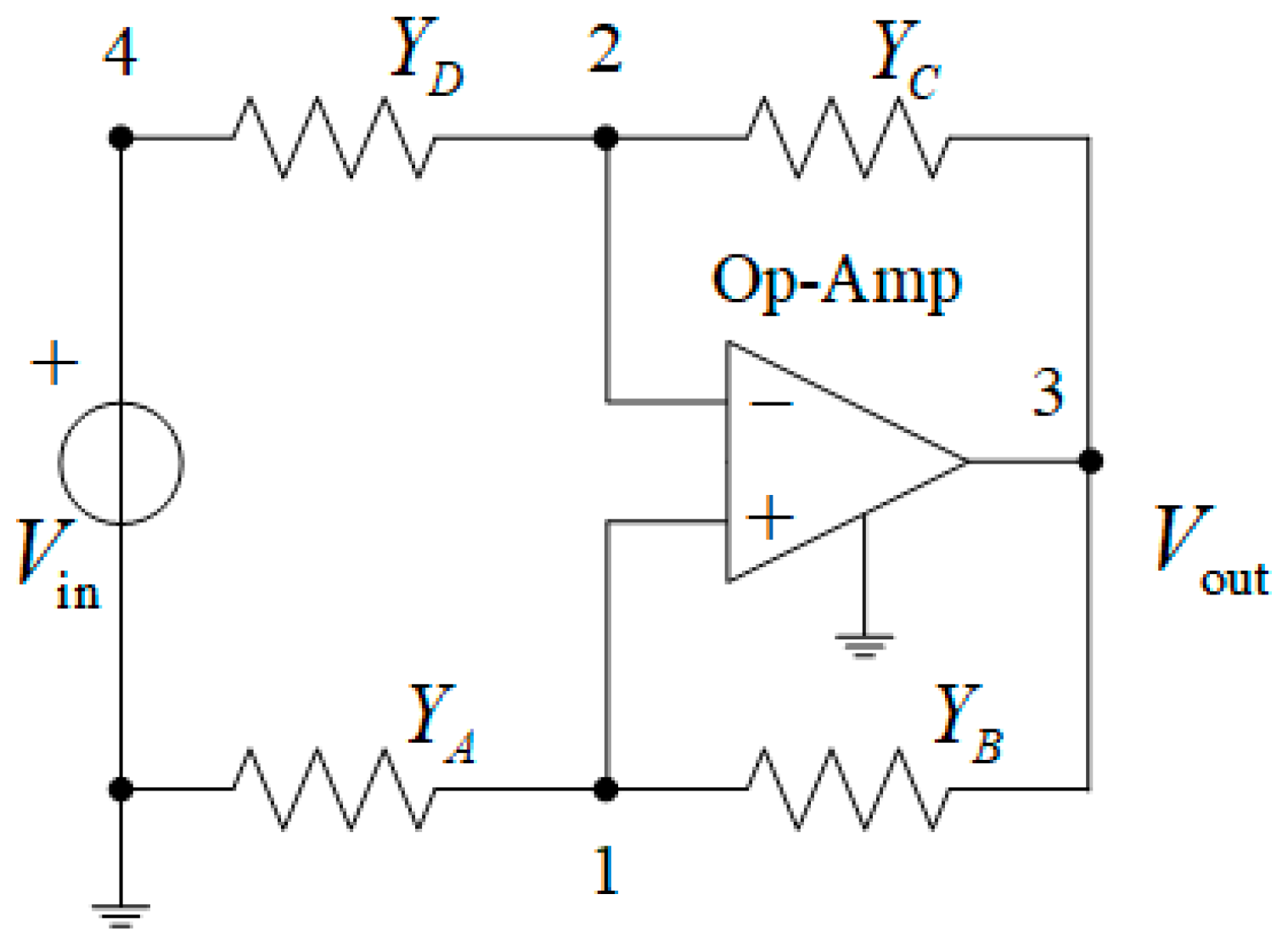
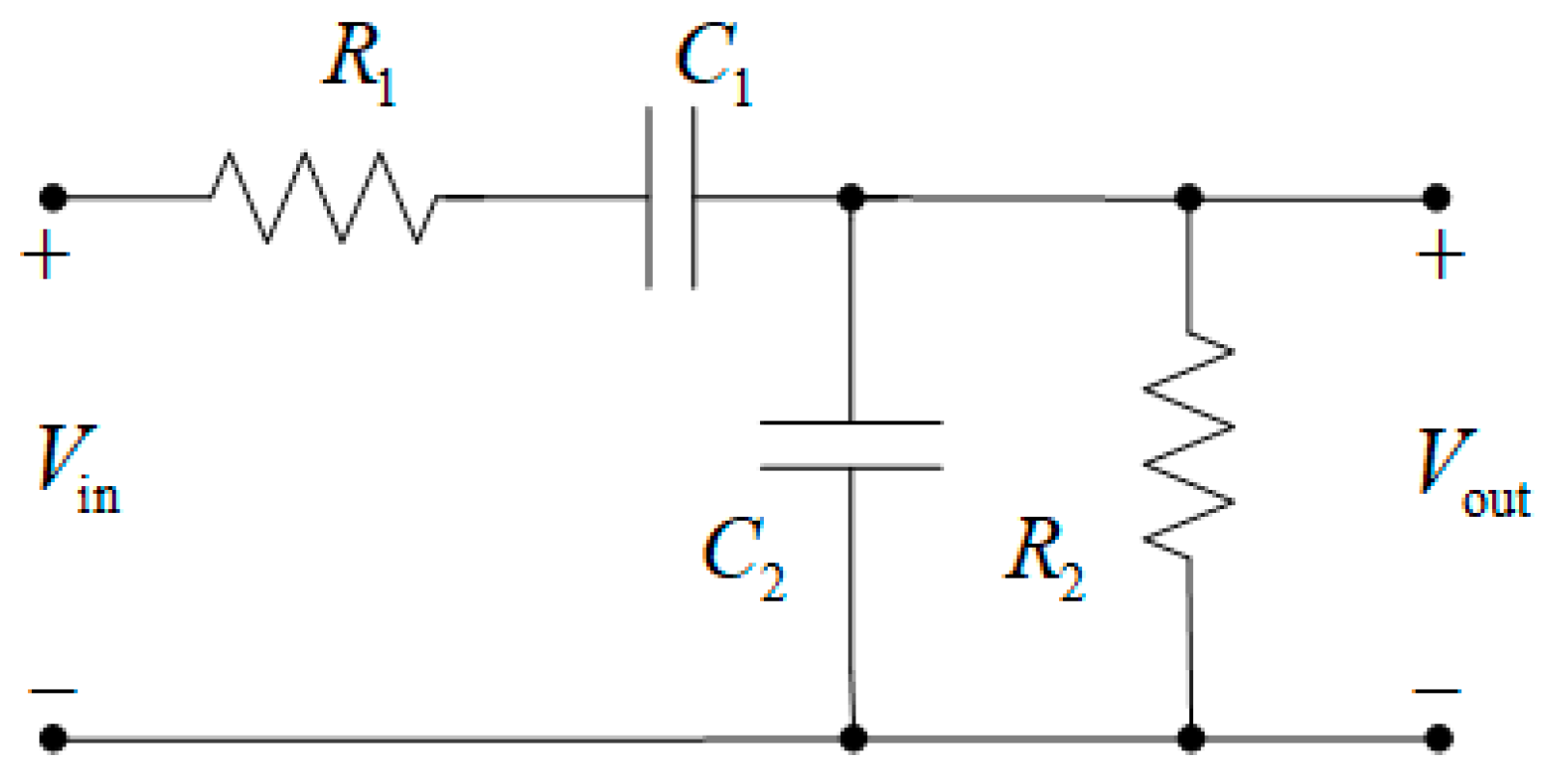
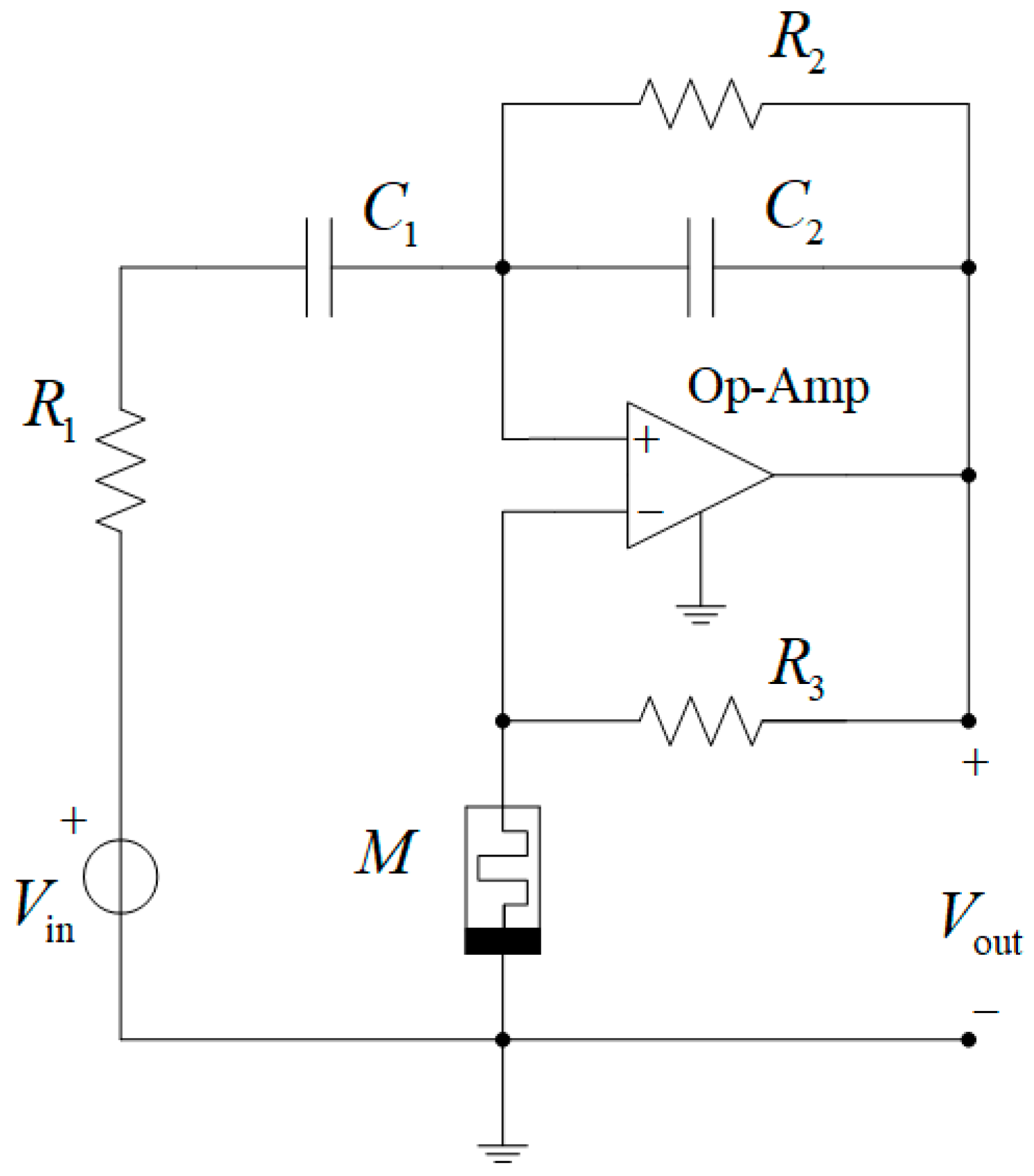
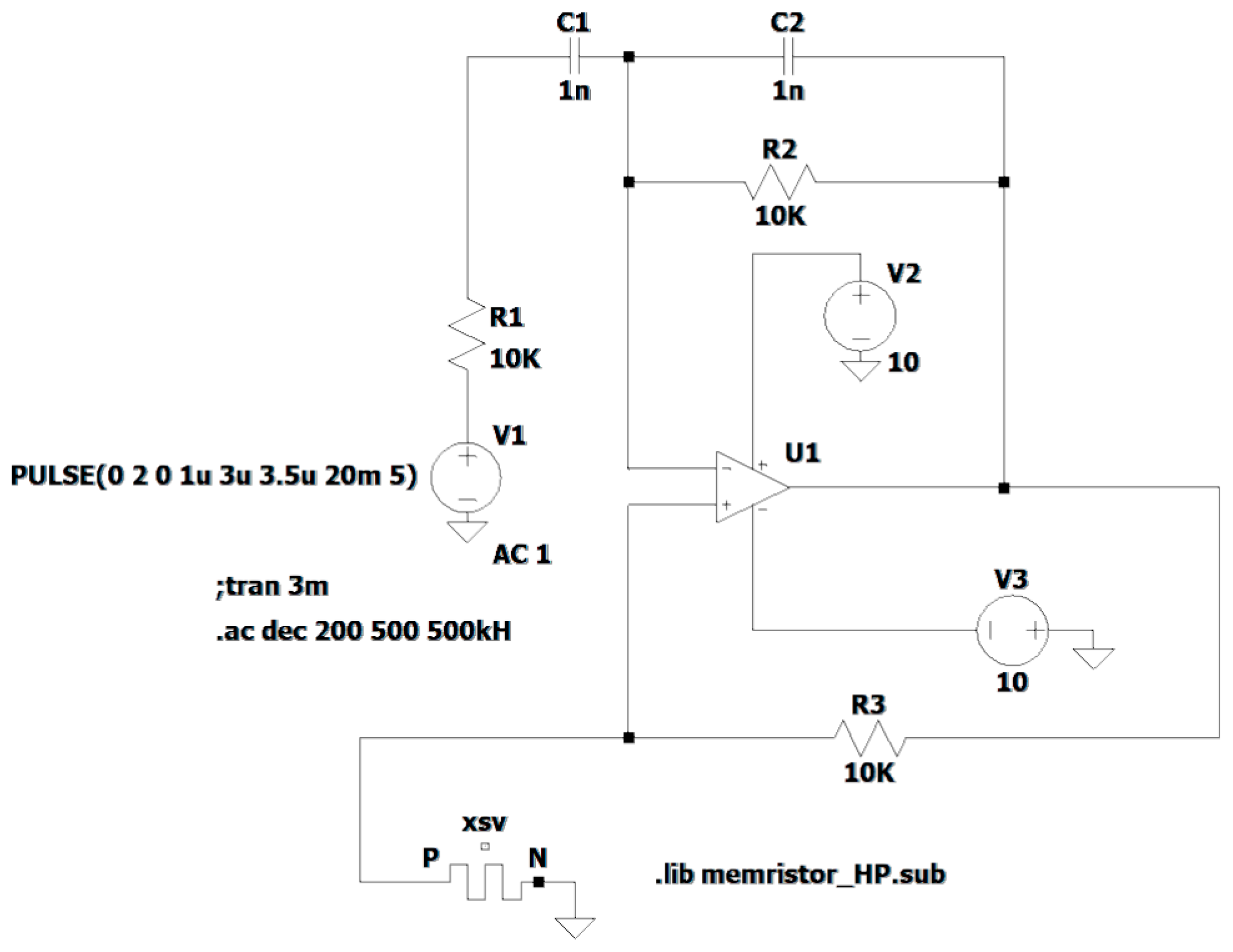
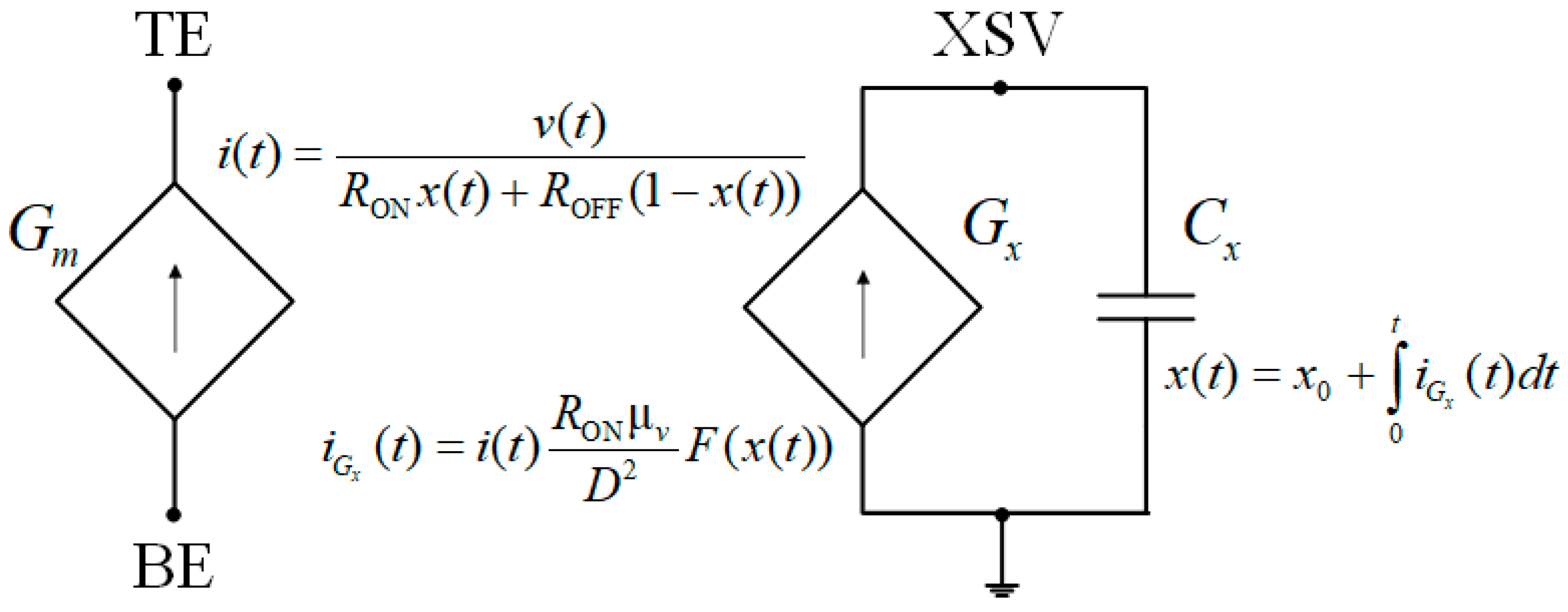
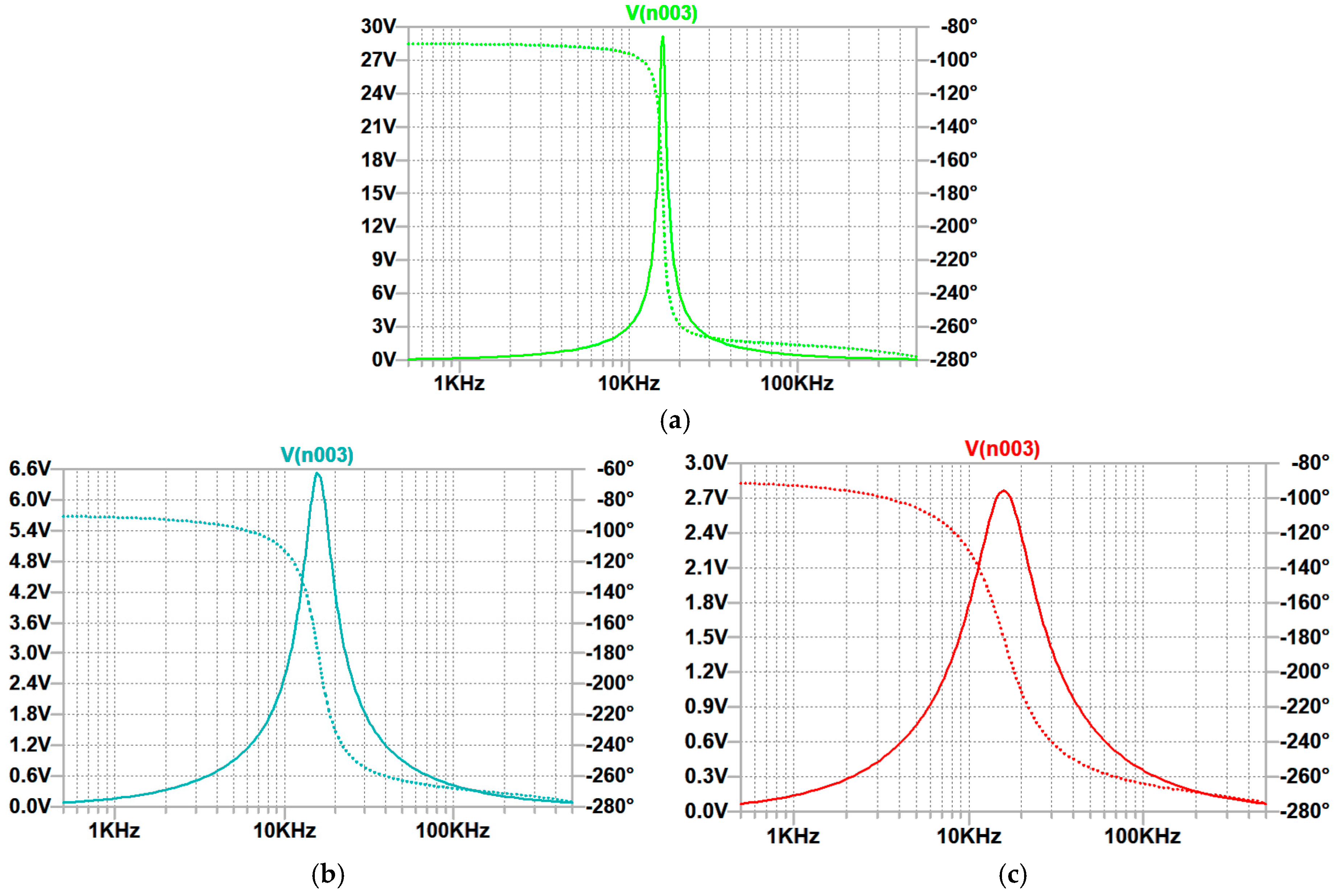
| Initial Voltage Across | Values Obtained from Frequency Responses in LTspice | Values Obtained from the Filter Transfer Function | |||||||
|---|---|---|---|---|---|---|---|---|---|
| , kHz | , kHz | , kΩ | , kHz | , kΩ | |||||
| 0.05 | 15.82 | 1.56 | 10.14 | 19.01 | 29.08 | 15.91 | 10.20 | 19.01 | 29.30 |
| 0.1 | 15.83 | 3.14 | 5.04 | 18.01 | 14.06 | 15.91 | 5.06 | 18.01 | 14.07 |
| 0.2 | 15.91 | 6.3 | 2.52 | 16.02 | 6.53 | 15.91 | 2.52 | 16.04 | 6.57 |
| 0.3 | 15.92 | 9.43 | 1.69 | 14.03 | 4.02 | 15.91 | 1.69 | 14.07 | 4.06 |
| 0.4 | 15.91 | 12.5 | 1.27 | 12.04 | 2.77 | 15.91 | 1.27 | 12.14 | 2.82 |
Disclaimer/Publisher’s Note: The statements, opinions and data contained in all publications are solely those of the individual author(s) and contributor(s) and not of MDPI and/or the editor(s). MDPI and/or the editor(s) disclaim responsibility for any injury to people or property resulting from any ideas, methods, instructions or products referred to in the content. |
© 2025 by the authors. Licensee MDPI, Basel, Switzerland. This article is an open access article distributed under the terms and conditions of the Creative Commons Attribution (CC BY) license (https://creativecommons.org/licenses/by/4.0/).
Share and Cite
Solovyeva, E.; Serdyuk, A.; Inshakov, Y. Tunable Active Wien Filters Based on Memristors. Micromachines 2025, 16, 769. https://doi.org/10.3390/mi16070769
Solovyeva E, Serdyuk A, Inshakov Y. Tunable Active Wien Filters Based on Memristors. Micromachines. 2025; 16(7):769. https://doi.org/10.3390/mi16070769
Chicago/Turabian StyleSolovyeva, Elena, Artyom Serdyuk, and Yury Inshakov. 2025. "Tunable Active Wien Filters Based on Memristors" Micromachines 16, no. 7: 769. https://doi.org/10.3390/mi16070769
APA StyleSolovyeva, E., Serdyuk, A., & Inshakov, Y. (2025). Tunable Active Wien Filters Based on Memristors. Micromachines, 16(7), 769. https://doi.org/10.3390/mi16070769






